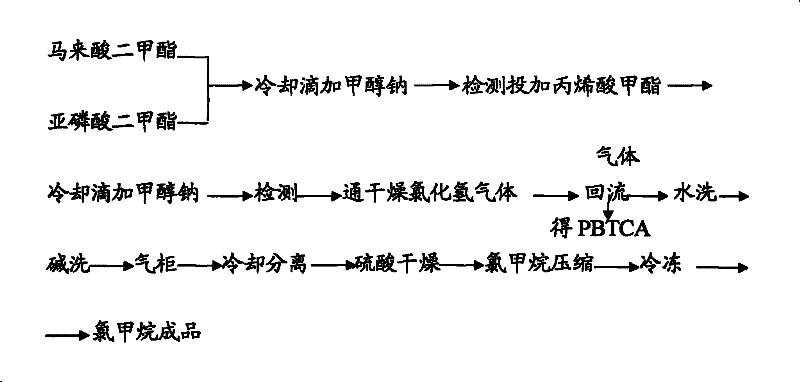Novel technique for coproduction of 2-phosphonobutane-1,2,4-tricabroxylic acid and methyl chloride
A technology of phosphonobutane and methyl chloride, which is applied in the chemical industry, can solve problems such as non-existence, and achieve the effects of reducing costs, protecting the environment, and absorbing high costs
- Summary
- Abstract
- Description
- Claims
- Application Information
AI Technical Summary
Problems solved by technology
Method used
Image
Examples
Embodiment 1
[0024] (1) Put 700 kg of dimethyl maleate and 540 kg of dimethyl phosphite into the reaction kettle, open the main kettle to freeze brine, add 30 kg of sodium methoxide dropwise, control the dropping temperature at 30°C, and pass the test after dropping Semi-finished tetramethyl phosphonosuccinate;
[0025] (2) Add 560 kg of methyl acrylate to the above-mentioned qualified semi-finished tetramethyl phosphonosuccinate, add dropwise 40 kg of sodium methoxide after cooling, control the dropping temperature at 25°C, and detect the qualified intermediate 2-phosphonic acid after dropping Pentamethyl butane-1,2,4-tricarboxylate;
[0026] (3) Pass 1780 kilograms of hydrogen chloride gas into the intermediate 2-phosphonobutane-1,2,4-tricarboxylate pentamethyl ester that is qualified as above-mentioned detection, control ventilation temperature 50 ℃, reflux 8 hours, detect and obtain Product 2-phosphonobutane-1,2,4-tricarboxylic acid, open the methyl chloride recovery device at the sam...
Embodiment 2
[0032] (1) Put 700 kg of dimethyl maleate and 540 kg of dimethyl phosphite into the reaction kettle, open the main kettle to freeze brine, add 25 kg of sodium methoxide dropwise, control the dropping temperature at 50°C, and pass the test after dropping Semi-finished tetramethyl phosphonosuccinate;
[0033] (2) Add 550 kg of methyl acrylate to the above-mentioned qualified semi-finished tetramethyl phosphonosuccinate, add 35 kg of sodium methoxide dropwise after cooling, control the dropping temperature at 50°C, and obtain the qualified intermediate 2-phosphonic acid after dropping Pentamethyl butane-1,2,4-tricarboxylate;
[0034] (3) Pass into 2150 kilograms of hydrogen chloride gas in the intermediate 2-phosphonobutane-1,2,4-tricarboxylate pentamethyl ester that is qualified as above-mentioned detection, control aeration temperature 70 ℃, reflux 9 hours, detect and obtain Product 2-phosphonobutane-1,2,4-tricarboxylic acid, open the methyl chloride recovery device at the sam...
Embodiment 3
[0040] (1) Put 700 kg of dimethyl maleate and 540 kg of dimethyl phosphite into the reaction kettle, open the main kettle to freeze the brine, add 37 kg of sodium methoxide dropwise, control the dropwise addition temperature at 70°C, and pass the test after dropping Semi-finished tetramethyl phosphonosuccinate;
[0041] (2) Add 630 kg of methyl acrylate to the above-mentioned qualified semi-finished tetramethyl phosphonosuccinate, add 56 kg of sodium methoxide dropwise after cooling, control the dropping temperature at 80°C, and obtain the qualified intermediate 2-phosphonic acid after dropping Pentamethyl butane-1,2,4-tricarboxylate;
[0042] (3) Pass 2150 kilograms of hydrogen chloride gas into the intermediate 2-phosphonobutane-1,2,4-tricarboxylate pentamethyl ester that is qualified as above-mentioned detection, control ventilation temperature 80 ℃, reflux 10 hours, detect and obtain Product 2-phosphonobutane-1,2,4-tricarboxylic acid, open the methyl chloride recovery dev...
PUM
 Login to View More
Login to View More Abstract
Description
Claims
Application Information
 Login to View More
Login to View More - R&D
- Intellectual Property
- Life Sciences
- Materials
- Tech Scout
- Unparalleled Data Quality
- Higher Quality Content
- 60% Fewer Hallucinations
Browse by: Latest US Patents, China's latest patents, Technical Efficacy Thesaurus, Application Domain, Technology Topic, Popular Technical Reports.
© 2025 PatSnap. All rights reserved.Legal|Privacy policy|Modern Slavery Act Transparency Statement|Sitemap|About US| Contact US: help@patsnap.com


